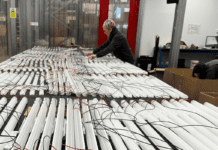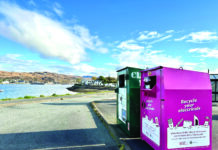
A comprehensive two year investigation into countering illegal exports of WEEE across Europe has revealed that 10 times more WEEE is mismanaged and discarded within Europe itself than the actual volume exported. Surprisingly, some 4.7 million tonnes of WEEE was wrongfully or illegally traded in the EU compared with the 400,000 tonnes of e-waste which was exported.
The European Union-funded project, Countering WEEE (waste electrical and electronic equipment) Illegal Trade (CWIT), was undertaken by INTERPOL, United Nations University (UNU), United Nations Interregional Crime and Justice Research Institute, the WEEE Forum, the Cross Border Research Association, Zanasi & Partners and Compliance and Risks.
The report includes recommendations to better enforce laws, monitor e-waste trade with suggestions for improved cooperation to make stringent EU regulations function.
Member states falling short of targets
Doctor Philip Morton, CEO of REPIC, said to be the UK’s largest producer compliance scheme for the collection and recycling of WEEE, and WEEE Forum President, said of the findings: “The study has revealed some suprising and significant findings. Whilst the proportion of illegally exported volumes of WEEE is lower than generally expected it is still a concern that needs addressing to protect vulnerable people in developing countries and to minimise environmental impact.
“The scale of the mismanagement of WEEE across EU Member States that isn’t properly counted and/or treated is a serious challenge and this adds to the argument that member states need to rigorously identify and include WEEE collected and treated through all routes as foreseen by the Directive by way of “substantiated estimates”.
“It’s significant to note that even if all illegal exports were stopped it wouldn’t in isolation allow Member states to meet their targets for WEEE collection – going forward we must count WEEE that is correctly recycled in Europe through all channels – not just that which goes through Producer Schemes.”
Phil concludes: “Reaching EU’s e-waste targets is a big challenge, and every citizen plays a critical role. Unless consumers and other market actors retire their small equipment at collection points and refrain from throwing it in the waste bin, there will be little to collect. We need better communication, greater awareness and effective ways to improve behaviour throughout the chain. Building on the CWIT UNU WEEE Stocks and Flows Model, our new EU-funded project (2015-17), called ProSUM, will inventory secondary raw materials in the urban mine and mining wastes.”
The summarised overall findings are:
· In Europe just 35% (3.3 million tonnes of 9.5 million tonnes) of used (but still functioning) and waste electronics and electrical equipment discarded by companies and consumers in 2012 wound up in official collection and recycling systems.
· The other discarded electronics – 6.2 million tonnes in all – was either exported, recycled under non-compliant conditions or simply thrown in waste bins.
· The study estimates 1.3 million tonnes of discarded electronics departed the EU in undocumented mixed exports, of which an estimated 30% (about 400,000 tonnes) was electronic waste; and 70% functioning equipment.
· More than 10 times the 400,000 tonnes of e-waste exported – some 4.7 million tonnes – was wrongfully mismanaged or illegally traded within Europe itself. And, the research found, even in the few EU member states with robust, effective reporting systems, monitoring of de-pollution efforts and up-to-standard treatment conditions are not always securely in place.
· The widespread theft of valuable components such as circuit boards and precious metals from waste electronics results in a serious loss of materials and resources for compliant waste processors in Europe. This annual estimated loss is valued at between €800 million and €1.7 billion (US $877 million to $1.86 billion).
· Avoided costs of compliance with EU regulations (mainly de-pollution), is estimated at €150 million to €600 million (US $165 million to $658 million) annually.
· According to Pascal Leroy, Secretary-General of the WEEE Forum: “Electronic and electrical equipment represents the fastest-growing flow of the world’s waste streams. The weight of Europe’s mismanaged e-waste alone equals that of a 10 meter high brick wall stretching from Oslo to the toe of Italy. Valuable metals and components, including critical raw materials, need to be safely captured and recycled to the fullest possible extent.”
· A UNU study last year said toxic materials in the world’s annual 41.8 million tonnes of discarded electronics include lead in glass (an estimated 2.2 million tonnes), batteries (300,000 tonnes), mercury, cadmium, chromium and ozone-depleting substances (CFCs, 4,400 tonnes). Health problems associated with such toxins include impaired mental development, cancer and damage to livers and kidneys.
· National surveys by INTERPOL show that on average each year only 2,000 tonnes (0.5%) of EU e-waste exports were reported as having been stopped in operations leading to some form of sentencing, administrative fines or civil penalties.
· The report notes that 30% of EU members have not implemented the stringent regulations required by the latest version of the WEEE directive and that typical national penalties for infractions at the national level are not high enough to have deterrent value.
· The report calls for better guidelines and formal definitions to help authorities distinguish used, non-waste electronics and electrical equipment from e-waste (equipment coming out of use or in post-use storage destined for collection or disposal).
The CWIT final summary report can be downloaded from the CWIT website.







